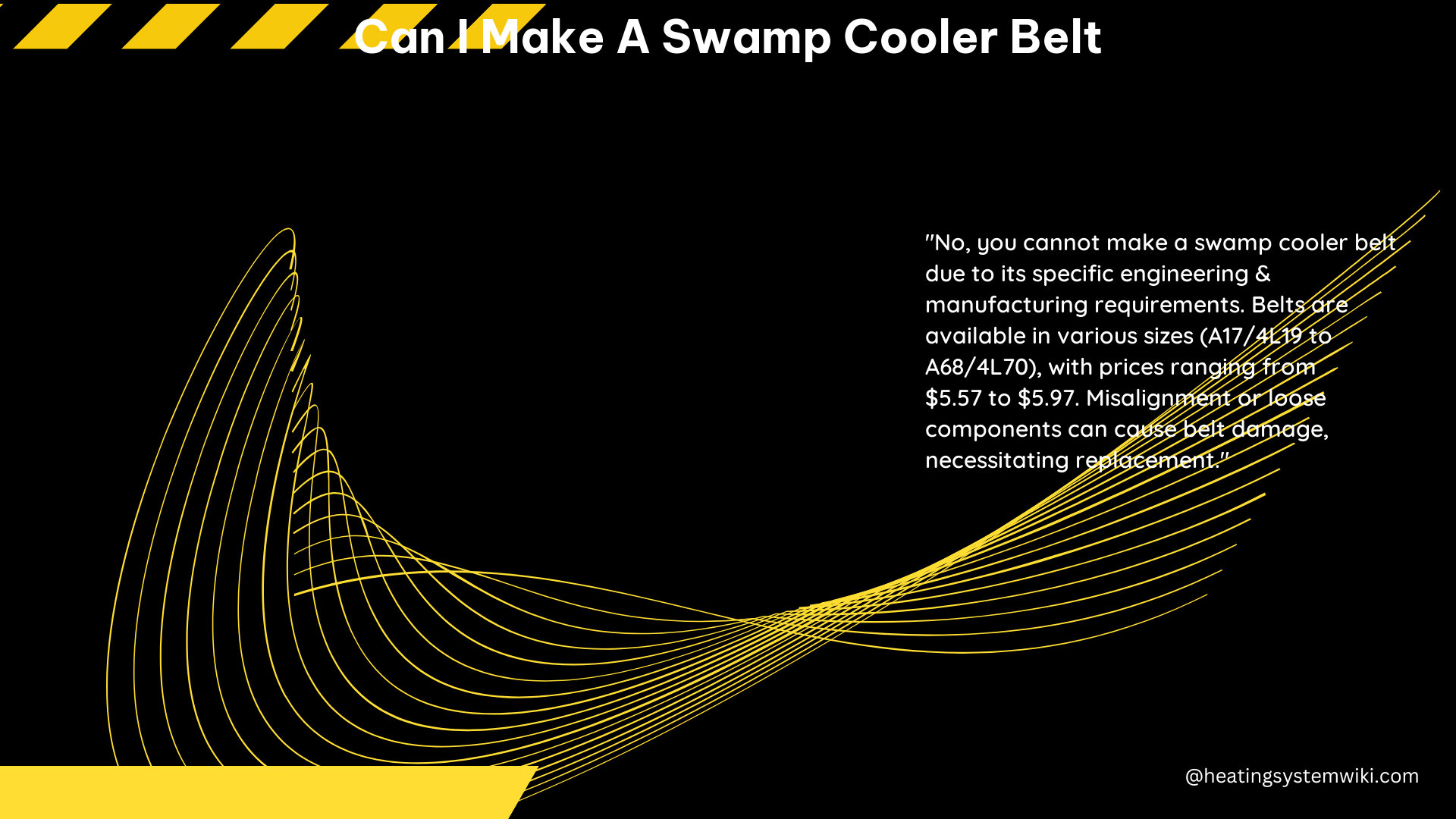Making a homemade swamp cooler belt is a feasible DIY project, but it requires careful consideration of the technical specifications to ensure its effectiveness. While a forum member has shared their experience of creating swamp cooler pads using blue foam cooler padding, the effectiveness of a homemade belt may vary compared to commercial options.
Understanding the Importance of Material Selection
The material used for a swamp cooler belt is crucial in determining its ability to hold water and create sufficient humidity to cool the air effectively. Commercial swamp cooler belts are typically made of a dense media that is designed to absorb and retain a large amount of water.
When selecting a material for a homemade swamp cooler belt, it’s essential to consider the following factors:
- Water Absorption Capacity: The material should have a high water absorption capacity, allowing it to hold a significant amount of water and release it as evaporative cooling.
- Porosity: The material should be porous enough to allow air to pass through and facilitate the evaporation process, but not too porous that it loses water too quickly.
- Durability: The material should be durable enough to withstand the constant wetting and drying cycles, as well as the mechanical stress of the belt’s movement.
Some potential materials that may be suitable for a homemade swamp cooler belt include:
- High-density foam (e.g., blue foam cooler padding)
- Cellulose-based materials (e.g., paper, cardboard)
- Synthetic fabrics with high water absorption properties (e.g., microfiber)
It’s important to experiment with different materials and test their performance to find the most suitable option for your specific swamp cooler setup.
Determining the Optimal Belt Thickness

The thickness of the swamp cooler belt is another crucial factor that can impact its efficiency. A thicker belt can hold more water and create more humidity, but it may also put additional strain on the motor.
When determining the optimal belt thickness, consider the following guidelines:
- Commercial swamp cooler belts typically range from 1/4 inch to 1 inch in thickness.
- A thicker belt (e.g., 3/4 inch to 1 inch) can hold more water and create more humidity, but it may require a more powerful motor to drive the belt.
- A thinner belt (e.g., 1/4 inch to 1/2 inch) may be easier on the motor, but it may not be as effective in creating the desired cooling effect.
It’s important to strike a balance between the belt’s water-holding capacity and the motor’s ability to drive the belt efficiently. Experimentation and testing may be necessary to find the optimal thickness for your specific swamp cooler setup.
Adjusting the Belt Tension
The tension of the swamp cooler belt is another critical factor that can impact the efficiency of the system. If the belt is too tight, it can put excessive strain on the motor, leading to premature wear and tear. Conversely, if the belt is too loose, it may slip and not create enough humidity.
When adjusting the belt tension, consider the following guidelines:
- Commercial swamp cooler belts typically have a tension range of 10-15 pounds of force (lbf) when measured with a belt tension gauge.
- For a homemade swamp cooler belt, you can use a simple spring scale or a digital force gauge to measure the tension.
- Adjust the belt tension gradually, checking the motor’s performance and the belt’s ability to create the desired humidity level.
- Refer to the manufacturer’s recommendations or consult with experienced swamp cooler users to determine the optimal tension range for your specific setup.
Proper belt tension is crucial for the efficient operation of your swamp cooler, so it’s essential to take the time to adjust and monitor the tension regularly.
Maintaining and Troubleshooting the Homemade Swamp Cooler Belt
Maintaining and troubleshooting a homemade swamp cooler belt is essential to ensure its long-term performance and reliability. Here are some tips to consider:
- Cleaning and Disinfecting: Regularly clean and disinfect the belt to prevent the buildup of mold, mildew, and other contaminants that can affect the water absorption and evaporation process.
- Replacing the Belt: Over time, the belt may wear down or become less effective. Be prepared to replace the belt as needed, and consider keeping a spare on hand.
- Monitoring Belt Condition: Regularly inspect the belt for signs of wear, such as cracks, tears, or a buildup of mineral deposits. Address any issues promptly to maintain the belt’s performance.
- Adjusting Tension: Periodically check and adjust the belt tension to ensure it’s within the recommended range, as changes in temperature and humidity can affect the tension over time.
By following these maintenance and troubleshooting tips, you can help ensure that your homemade swamp cooler belt continues to perform effectively and efficiently.
Conclusion
While it is possible to make a swamp cooler belt at home, it’s essential to carefully consider the technical specifications to ensure its effectiveness. The selection of the right material, the optimal belt thickness, and the proper tension adjustment are all critical factors that can impact the performance of your homemade swamp cooler belt.
By understanding these technical considerations and following best practices for maintenance and troubleshooting, you can create a homemade swamp cooler belt that can provide effective and efficient cooling for your home or workspace.
